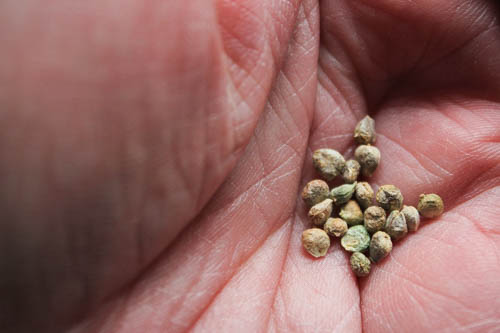
March is the month of seed sowing, especially in the vegetable garden. Start preparing your seedbeds beforehand by raking the ground to a rough level and covering it with clear or black polythene to warm the soil. Clear polythene is preferable, as it encourages weed seeds to germinate which can be hoed off beforehand, so they don’t compete with your germinating crops. Most seeds take longer to germinate in lower temperatures and may not germinate at all, if the soil is too cold. Be dictated to by the weather, it is not worth sowing until conditions are favourable and crops soon catch up by germinating and growing more rapidly when conditions are good. The soil should be damp enough to encourage germination, not dry or cold and waterlogged, the seedbed firm and free of weeds and stones. If the soil sticks to your boots when you walk on it, the ground is too wet.
Peas and parsnips take four weeks or more to appear if sown in early spring, when the soil is cold but only ten days if temperatures are higher. Turnips, radishes, broad beans and peas germinate when the soil temperature is above 41F (5C), Leeks and onions need a minimum temperature of 45F(7C) and it is also the minimum temperature for potatoes to grow. Lettuce germinates well when it’s cool but not when soil temperatures are above 77F (25C) so there are upper limits for germination when sowing in summer, too. A soil thermometer takes the risk out of sowing.
Beetroot, broad bean, carrot, kohl rabi, leeks, lettuce, pea, radish, salad leaves, spinach, Swiss chard and turnip can be your earliest sowings. Choose ‘bolting’ resistant varieties to reduce the risk of early sowings running to seed prematurely, then cover the ground with cloches or horticultural fleece to protect emerging seedlings from pests and diseases and the effects of chilling winds. Make extra sowings in modules or plugs indoors or on a sunny windowsill as a back-up.
Most crops are like peas and beans are sown directly into the soil, though in places where the growing season is short or for earlier crops, they can be started indoors in a greenhouse or on a window sill. Indoor sowing is reserved mainly for crops like French or Runner beans, Courgettes and squashes which cannot be planted until the danger of frost has passed.
Onions can be planted from ‘sets’, pushing them into the soil, until only the tips can be seen, when soil and weather conditions improve. Leave heat treated ‘sets’ until later in the month. Planting 15cm apart gives high yields of medium sized bulbs.
Early to mid-March is the end of the planting season for ‘bare root’ plants like trees, hedging, roses; search websites now for a bargain and plant them immediately, before they burst into growth but not if the soil is waterlogged or frozen. The choice is not as wide as it would be earlier in the planting season but if there is space in your garden, there’s money to be saved.
Start controlling slugs in the garden to reduce problems later in the year.
Happy gardening, Matt.


